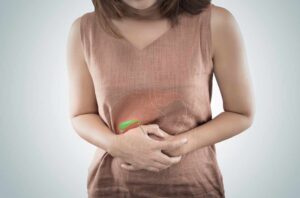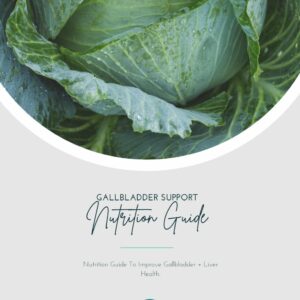What Are Gallbladder Polyps, and Are They Harmful to Your Health?
Gallbladder disease can certainly come with its fair share of complications. Unfortunately, gallbladder health is often overlooked until complications occur.
If you’re someone who struggles with gallbladder disease, you’ve likely had to deal with the discomfort gallbladder complications can cause.
Gallstones, bile sludge, fatty liver– these are all common conditions associated with gallbladder diseases…
But are you familiar with gallbladder polyps?
Gallbladder polyps stand out as a lesser-known but significant gallbladder issue. Polyps can form in the gallbladder and are often mistaken for gallstones.
As a functional nutritionist focusing on all things gallbladder, I’m passionate about shedding light on all gallbladder conditions– including gallbladder polyps. So that’s what I’ll be doing here!
In this blog, we’ll dive into the world of gallbladder polyps and how to distinguish them from gallstones. Plus, I’ll provide you with recommendations for managing your gallbladder disease and gallbladder polyps. Let’s jump in!
Understanding Gallbladder Polyps: What Is a Gallbladder Polyp?
Gallbladder polyps are small, typically harmless lesions. They form in the mucosal wall of the gallbladder and are usually less than 1 centimeter in diameter.
There are different types of gallbladder polyps, but the most common types are cholesterol-based. About 60% of cases observed are cholesterol gallbladder polyps.
The incidence of gallbladder polyps is fairly equal between males and females.
However, common risk factors for the development of gallbladder polyps include1:
- Older age (more common over the age of 40)
- Hypertension
- Diabetes
- Hepatitis C infection
- Obesity
About 95 percent of gallbladder polyps are benign2, and nothing to worry about!
However– with any abnormality in the body– there’s always a potential risk for complications with untreated or undiagnosed gallbladder polyps.
Gallbladder polyps larger than ½ an inch or 10mm in diameter are more likely to turn into cancer with time. Polyps bigger than ¾ an inch or 18mm in diameter can pose a significant risk of being malignant.3
So how do you know if you have a gallbladder polyp that’s worth assessing?
Recognizing Symptoms of Gallbladder Polyps
Oftentimes, gallbladder polyps can be asymptomatic. This means you may not even experience any symptoms despite the presence of polyps.
But if you do experience symptoms, common signs of gallbladder polyps include:
- Abdominal discomfort – particularly in the right upper abdomen
- Nausea or vomiting
- Changes in bowel movements
However- its important to note that gallbladder polyps usually do not cause symptoms. I often find working with gallbladder clients there is a misdiagnosis of gallstones or poor gallbladder function.
The best way to determine whether your symptoms indicate gallbladder polyps or gallstones is to seek imaging studies through your doctor.
In most cases you will need to request further imaging or a hida scan with ejection fraction to evaluation if the gallbladder function is causing gallbladder symtpoms.
Distinguishing Gallbladder Polyps From Gallstones

Gallbladder polyps and gallstones are fundamentally different in their composition and formation. As mentioned above, gallbladder polyps are formed in the mucosal lining of your gallbladder.
Gallstones on the other hand are formed when the bile inside your gallbladder becomes too saturated with cholesterol and hardens into stone-like material.
So as two separate conditions, it’s important to work with your doctor to understand what is really going on in your gallbladder. And imaging studies can give you a clearer picture.
Gallbladder polyps can be differentiated from gallstones through imaging studies like ultrasound imaging. Non-invasive abdominal ultrasounds can usually pick up gallbladder polyps, although some doctors may choose to evaluate the gallbladder with a minimally invasive endoscopic ultrasound.
Additional imaging studies include CT scans and MRCPs– or magnetic resonance cholangiopancreatography.1 An MRCP is a special kind of MRI designed to look at your biliary and pancreatic system– including your gallbladder.
In asymptomatic cases, gallbladder polyps are often found incidentally on an ultrasound.3
However, if you experience any of the symptoms listed above, a doctor should provide you with an ultrasound to determine if you’re dealing with gallbladder polyps or gallbladder stones.
With the widespread use of ultrasounds, gallbladder polyps are increasingly detected. And imaging is crucial in determining the possibility of gallbladder carcinoma or premalignant adenomas when observing gallbladder polyps.3
Recommended Treatments for Gallbladder Polyps
The proper treatment for gallbladder polyps isn’t too different from treatment recommendations for gallstones.
The first-line treatment for gallbladder polyps is non-surgical. Dietary and lifestyle adjustments can help manage the symptoms of gallbladder polyps.
Here are some nutrition recommendations for managing gallbladder polyp symptoms4:
- Stick to a whole food diet with leafy greens and root vegetables like beets or carrots.
- Reduce inflammatory foods, processed foods, refined sugars and vegetable oils.
- Boost key nutrients for gallbladder and liver health: bitter greens, turmeric, beets, artichoke, lemon, asparagus.
- Address high cholesterol starting with inflammation. Polyps are thought to be derived from high cholesterol- similar to cholesterol gallstones. Inflammation drives high cholesterol production. As a gallbladder nutritionist we can work together to reduce inflammation and improve cholesterol metabolism to shrink the polyps.
- Consider medication use, especially birth control. Birth control has been known to be a contributor to cholesterol gallstones. Similar to gallstones, birth control increases risk of gallbladder polyps.
In addition to a healthy diet, always maintain an exercise regimen that feels good for your body. Try to move your body daily with walks, low-impact cardio, or strength training.
With gallbladder polyps less than 10mm, your doctor may recommend routine gallbladder ultrasounds to track any growth of the polyp that could potentially lead to cancer. It is important to do routine ultrasounds to check the growth of polyps. If the polyps grow substantially in size or you grow more in a short amount of time, surgery maybe recommended.
If lifestyle and diet changes don’t decrease your symptoms, or if your imaging shows a gallbladder polyp that’s at risk of becoming cancerous, surgical intervention is recommended.
Surgery is typically in the form of gallbladder removal surgery- or a cholecystectomy.
Post-gallbladder removal care is essential for ensuring a smooth recovery and maintaining gallbladder health. Often people are told they can eat whatever they want post-op, but that’s not the case.
Easing into a gallbladder-friendly diet is key to keeping post-op symptoms at bay.
Check out my post-gallbladder surgery recipe guide for more tips!
Managing Gallbladder Polyps and Gallbladder Disease
Okay– so we’ve learned a lot about gallbladder polyps. You now know gallbladder polyps and gallstones are two distinct yet interrelated conditions that can significantly impact your life if left untreated.
Understanding the nuanced differences between gallbladder polyps and gallstones will help you become a more empowered gallbladder disease patient. So you can make informed decisions about your health and be proactive about getting imaging if needed.
As a gallbladder nutritionist– and someone who has experienced gallbladder disease firsthand– I have been in your shoes.
And I know what it’s like to go down the research rabbit hole in search of what your symptoms mean. So I hope now you have a few more tools to understand your diagnosis and your decision-making for your health.
Depending on your gallbladder situation, I want to help you feel confident in your body. If you’re managing gallbladder polyps, gallstones, or other complications of gallbladder disease– the Gallbladder Saver Society is your guide to proper gallbladder treatment and remedies.
The Gallbladder Saver Society is a membership that’s packed with:
- Tons of course content on gallbladder health that gets updated monthly
- Gallbladder-friendly meal plans refreshed every month
- A community of other gallbladder warriors just like you to connect with for support
- Live Q & A session from me– a gallbladder functional nutritionist– here to answer any and all gallbladder-related questions you may have!
So take charge of your health, and learn all the tools to manage your gallbladder disease with ease and confidence. Join the Gallbladder Saver Society today!
In the meantime, I hope you can take the tips you’ve learned in this blog into your life. So you can feel empowered and knowledgeable about gallbladder polyps and gallbladder disease.
Resources
- Dilek ON, Karasu S, Dilek FH. Diagnosis and Treatment of Gallbladder Polyps: Current Perspectives. Euroasian J Hepatogastroenterol. 2019 Jan-Jun;9(1):40-48. doi: 10.5005/jp-journals-10018-1294. PMID: 31988866; PMCID: PMC6969319.
- Khanna, S. Gallbladder Polyps: Can They Be Cancerous? Mayo Clinic. 2023.
- Zakko, W., Zakko, S. Gallbladder Polyps. Up To Date. 2023.
- Frothingham, S., Sethi, S. Gallballder Polups. Healthline. 2018.

